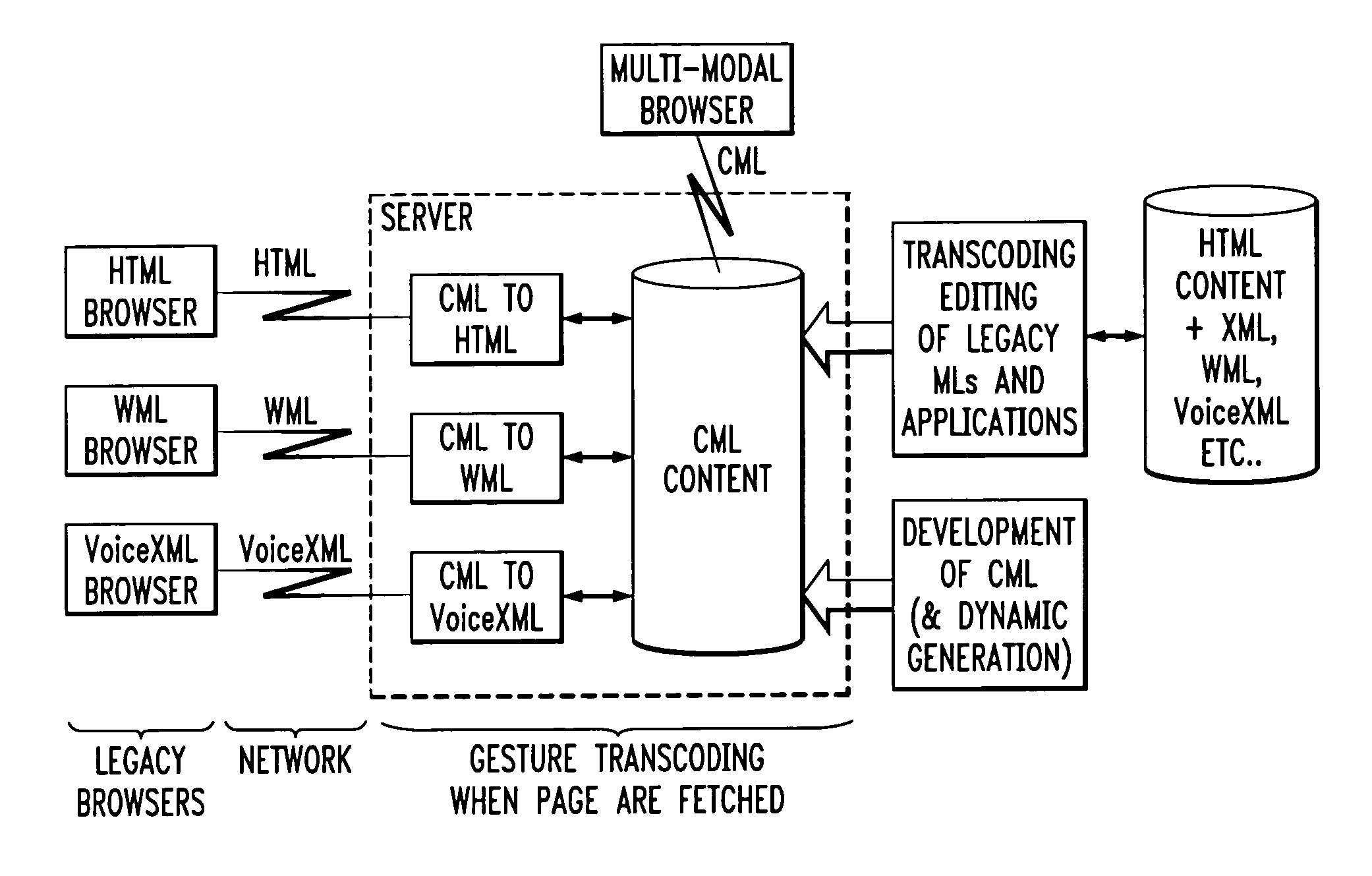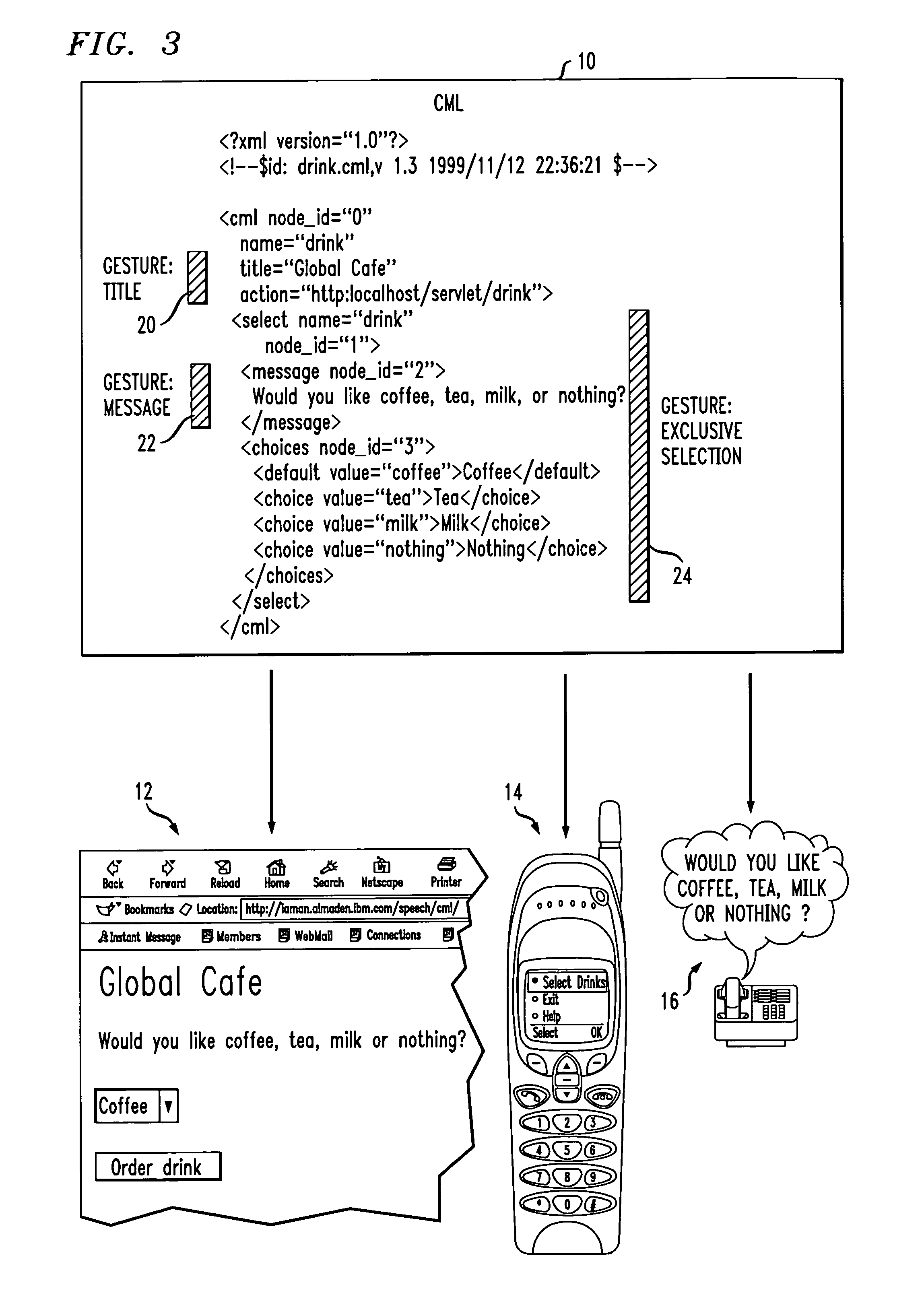[0021]In accordance with the invention, a device (
client or even
server serving CML pages into possibly other legacy markup languages like
HTML,
VoiceXML, WML etc.) operating with downloaded CML code can transcode to, for example,
HTML and
VoiceXML, substantially simultaneously so as to synchronize the multiple browsers providing the user with
access to information. Such advantageous synchronization according to the invention is possible because the
transcoding is done gesture by gesture with gesture identification. Thus, when an input / output event occurs in one modality, the browser knows what event occurred for what gesture and can immediately update all the supported modalities. This results in a very tight synchronization across modalities. Such synchronization is also achieved due to the fact that the various modality-specific
user interface dialogues, e.g., associated with a
graphical user interface (GUI) browser or a speech browser, are generated from a single CML representation, on a gesture by gesture basis. Thus, the multiple user interfaces, e.g., GUI, speech, etc., are synchronized and continuously updated as a user interactively proceeds with one or the other modality.
[0022]CML and the browsing mechanisms of the present invention also provide a platform for
natural language (NL)
programming. Since CML allows an application author to program gesture by gesture, such an application provides the flexibility for a user to provide requests / responses in a wide range of natural conversational manners. Thus, the user is not restricted to simple commands but rather can interact with an application in a less restrictive manner, e.g., more closely resembling a natural conversation. With NL and the invention, the user can express himself freely in multiple modalities, with no constraint other than to carry a natural conversation as if it was carried with another
human being. In the case of NL, in addition, the
system may use context and past interaction / dialog history (as well as other meta-information like user preferences, application settings, stored common knowledge, etc.) to disambiguate queries.
[0025]Given the modality-independence of CML, even after an application is written, any
transcoding rules associated with any type of browser may be implemented. That is, CML allows the author to change to another type of
transcoding (i.e., the gesture based transcoding rules), other than any default transcoding that may have originally been implemented. Thus, through simple updates of gesture based
XSL rules, this feature advantageously guarantees support for new releases / versions of the so-called “legacy languages,” e.g., HTML, WML, VoiceXML, etc., and for new languages, e.g., CHTML, HDML, etc. In addition, this feature permits a simple and easy passage from one version of CML to a new one using simple gesture based
XSL rules. It is to be appreciated that gesture by gesture transcoding from version to version is not a different problem from transcoding from CML to other legacy language. This is especially advantageous as CML is designed, by definition, around the principle of this transcoding. This is certainly not true for most of the other mark-up languages where upgrades of the specifications, while possibly offering backward compatibilities, are usually problematic for new generation browsers, as well as in with respect to all the older content written in older versions.
[0029]Given such aspects of the present invention, as well as others that will be explained below, we now discuss some important differences between such inventive features and existing approaches. The
exponential growth of the
World Wide Web (WWW) during the last five years has pointed out the inherent strength in constructing light-weight
user interface applications by first separating user interaction from content, and subsequently delivering application front-ends via markup languages like HTML that are rendered by a platform-independent WWW browser. This architecture opens up a new world of possibilities by liberating end-user applications from details of the underlying hardware and
operating system. The current WWW architecture has liberated visual interfaces to e-commerce applications from details of the underlying hardware and
operating system. The next step in this evolution is to make end-user applications independent of the interface modality and device used to interact with
electronic information. This evolution is the natural next step in enabling speech-based interaction with the new generation of e-commerce applications.
[0052]We first define the enumeration type PersonTitle:<enum name=“PersonTitle” type=“string”><value>MR< / value><value>MRS< / value><value>MISS< / value>< / enum>Once defined, field PersonTitle can be instantiated at multiple points in the user interaction via an appropriate CML gesture. Below we illustrate this with gesture select.<select name=“PersonTitle” selection-policy=“single”><message>Person Title< / mesage><choices><choicevalue=“MR”>Mr.< / choice><choicevalue=“MRS”>MRS.< / choice><choicevalue=“MISS”>Miss.< / choice>< / choices>< / select>Separating the conversational gesture (gesture select in the above example) from the definition of the underlying datatype (enumeration PersonTitle above) provides a number of advantages:
[0072]Tight synchronization across modalities is a basic design goal in CML. This is reflected throughout the CML design, and the resulting separation between conversational gestures and the definition of the
data model makes it easier to implement a multi-
modal browser that is constructed on top of the DOM using the classic
Model View Controller (MVC) design.(vi) Conversational Applications
 Login to View More
Login to View More  Login to View More
Login to View More 


